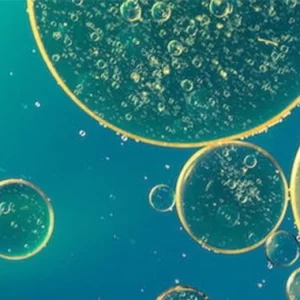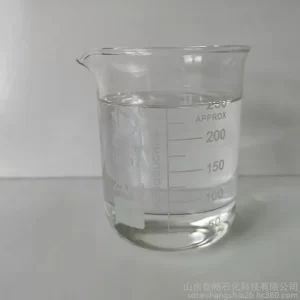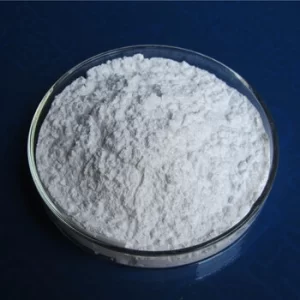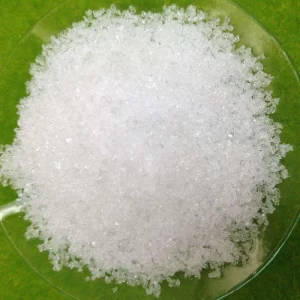What is Polyethylene Glycol Monooleyl Ether Chemical Definition and Synonyms
Polyethylene Glycol Monooleyl Ether is a non-ionic surfactant widely used across pharmaceutical, cosmetic, and industrial sectors. It is commonly known by synonyms such as PEG Oleyl Ether, Polyoxyethylene Oleyl Ether, and sometimes referenced by trade names like Brij 93. Its chemical identity is represented by the CAS number 9004-98-2.
Molecular Structure and IUPAC Name
Chemically, Polyethylene Glycol Monooleyl Ether consists of a hydrophobic oleyl (C18H34) alkyl chain linked to a hydrophilic polyethylene glycol (PEG) chain. The general molecular structure can be described as:
(C2H4O)n-C18H34
where n denotes the number of ethylene oxide units (PEG chain length), which can be customized depending on the required hydrophilic-lipophilic balance (HLB) for specific applications.
The IUPAC name for this compound is O-(2-hydroxyethyl)ethylene glycol monooleyl ether or sometimes referred to as polyoxyethylene (20) oleyl ether when the average number of ethylene oxide units is around 20.
Key Physical and Chemical Properties
Understanding the physical and chemical characteristics of Polyethylene Glycol Monooleyl Ether is vital for its effective use:
- Appearance: Clear to pale yellow viscous liquid
- Molecular Weight: Variable, depending on the PEG chain length (commonly ranges from 500 to 1500 g/mol)
- Hydrophilic-Lipophilic Balance (HLB): Typically between 11 and 13, suitable for oil-in-water emulsions
- Solubility: Soluble in water, alcohols, and some organic solvents
- Boiling Point: Decomposes before boiling in most cases due to the polymeric nature
- pH: Usually neutral to slightly alkaline (pH 6-8 in aqueous solution)
- Stability: Chemically stable under normal conditions, resistant to hydrolysis and oxidation
- Surface Activity: Excellent emulsifying and wetting properties due to its amphiphilic nature
Polyethylene Glycol Monooleyl Ether’s carefully balanced molecular design allows it to reduce surface tension effectively, making it ideal as a surfactant and emulsifier in formulations requiring mild yet efficient surface activity.
For more information on related polyethylene glycol products, you can explore Polypropylene Glycol CAS 25322-69-4 or Polyether Modified Dimethicone BL 272 for applications needing silicone-based surfactants.
Applications of Polyethylene Glycol Monooleyl Ether Non Ionic Surfactant CAS 9004-98-2
Polyethylene Glycol Monooleyl Ether (PEG Oleyl Ether) is widely used across various industries due to its excellent properties as a non-ionic surfactant. Its versatility makes it a vital ingredient in pharmaceuticals, cosmetics, and industrial applications. Here’s a detailed look at its key uses:
Pharmaceutical Applications
In the pharmaceutical world, Polyethylene Glycol Monooleyl Ether acts as a pharmaceutical emulsifier and solubilizer. It helps improve the bioavailability of poorly soluble drugs, enabling stable emulsions and suspensions in formulations like creams, ointments, and injectables. Its low toxicity and compatibility with active ingredients make it suitable for oral, topical, and parenteral preparations.
Use in Cosmetic Formulations
This surfactant is a trusted choice in cosmetics. It functions as a cosmetic surfactant and emulsifier, helping to blend oils and water-based ingredients smoothly. It enhances the texture, spreadability, and stability of lotions, shampoos, conditioners, and makeup products. The mildness and low irritation potential make it ideal for sensitive skin products.
Industrial Applications
Polyethylene Glycol Monooleyl Ether plays several roles in industrial settings. It’s used as a wetting agent, dispersant, and lubricant in manufacturing processes. The surfactant eases the mixing of hydrophobic and hydrophilic materials, improves surface wetting, and provides lubrication in printing inks, paints, and coatings.
Specific Use Cases Depending on n-Values
The “n-value” in Polyethylene Glycol Monooleyl Ether refers to the average number of ethylene oxide units in the molecule. This number affects its hydrophilic-lipophilic balance (HLB) and thus its surfactant behavior:
- Low n-values (e.g., 3 to 5): More lipophilic, ideal for oil-soluble formulations, such as in certain ointments and industrial lubricants.
- Medium n-values (e.g., 7 to 9): Balanced HLB, widely used in emulsions where stable oil and water phases are required — common in pharmaceuticals and cosmetics.
- High n-values (above 10): More hydrophilic, better for water-soluble applications and creating clear, stable aqueous solutions.
Choosing the right PEG Oleyl Ether with a specific n-value helps optimize formulation performance for each intended application.
For related surfactants used in similar sectors, you can explore our range of Polyether Modified Silicone Fluids and Polypropylene Glycol CAS 25322-69-4.
In , Polyethylene Glycol Monooleyl Ether is essential for enhancing solubility, emulsification, and surface activity in many formulations, making it highly valuable for U.S. pharmaceutical, cosmetic, and industrial manufacturers.
Benefits of Using Blissam’s Polyethylene Glycol Monooleyl Ether
When you choose Blissam’s Polyethylene Glycol Monooleyl Ether (CAS 9004-98-2), you’re getting a product designed to meet the high standards of U.S. industries, especially in pharmaceuticals, cosmetics, and various industrial applications. Here’s what sets our PEG Oleyl Ether apart:
High Purity for Consistent Performance
Our product undergoes strict quality control, ensuring high purity levels that minimize impurities. This means you get a reliable surfactant with consistent chemical and physical properties every time. High purity is crucial for sensitive applications like pharmaceutical emulsifiers or skin-care products, where unwanted contaminants can cause issues.
Excellent Chemical Stability
Blissam’s Polyethylene Glycol Monooleyl Ether maintains stability under normal handling and storage conditions, resisting degradation from heat, light, or air exposure. This chemical stability helps extend shelf life and ensures your formulations maintain effectiveness over time.
Low Toxicity and Minimal Hypersensitivity
Safety is important. Our PEG Oleyl Ether shows low toxicity, making it suitable for use in pharmaceuticals and personal care products. Plus, it has a low risk of causing hypersensitivity or allergic reactions, an essential feature for cosmetic surfactants used in products designed for daily skin contact.
Customizable n-Values for Specific Needs
Understanding that different applications require different molecular chain lengths, Blissam offers customizable n-values. This flexibility lets you find the right balance between hydrophilic and lipophilic properties, tailoring performance for anything from mild cosmetic emulsification to tougher industrial formulations.
Reliable Supply Chain and Competitive Pricing
With Blissam, you get a trustworthy supply backed by a robust production network. This means you can count on timely deliveries and steady inventory levels. Plus, we offer competitive pricing without compromising quality, helping you manage costs while still accessing premium-grade polyethylene glycol ether.
Blissam’s commitment to quality, chemical stability, and flexible options makes our Polyethylene Glycol Monooleyl Ether a standout choice for U.S. customers looking for an effective, safe, and reliable non-ionic surfactant.
Safety and Handling Information for Polyethylene Glycol Monooleyl Ether CAS 9004-98-2
When working with Polyethylene Glycol Monooleyl Ether (PEG Oleyl Ether), understanding the safety and handling guidelines is essential to ensure safe use in your applications. Here’s what you need to know:
Toxicity Profile
Polyethylene Glycol Monooleyl Ether is generally considered low in toxicity. It shows minimal irritation to skin and eyes and has a favorable safety profile, making it suitable for pharmaceutical and cosmetic formulations where mildness is key. However, as with all chemicals, direct prolonged exposure should be avoided.
Safety Precautions
- Always use personal protective equipment (PPE) such as gloves and safety glasses when handling this chemical.
- Work in a well-ventilated area to reduce inhalation risk.
- Avoid direct contact with skin or eyes; if contact occurs, rinse thoroughly with water.
- Follow local disposal regulations to minimize environmental impact.
Availability of Safety Data Sheets
Blissam provides comprehensive Safety Data Sheets (SDS) for Polyethylene Glycol Monooleyl Ether CAS 9004-98-2 to guide you on safe storage, handling, and emergency measures. SDS files include detailed information on physical properties, toxicity, first-aid, fire-fighting measures, and spill response.
Environmental and Regulatory Considerations
- This non-ionic surfactant is biodegradable to a significant extent, reducing long-term environmental concerns when used responsibly.
- It complies with relevant U.S. Environmental Protection Agency (EPA) guidelines and other regional standards.
- When disposing of waste or residues, adhere to local, state, and federal regulations to prevent environmental contamination.
- Blissam ensures that its PEG Oleyl Ether meets safety requirements demanded by FDA and EPA standards for pharmaceutical and cosmetic ingredients.
By following these guidelines, you can confidently manage Polyethylene Glycol Monooleyl Ether in your operations while maintaining high safety and environmental standards.
Technical Specifications and Variants of Polyethylene Glycol Monooleyl Ether CAS 9004-98-2
Available Grades
Blissam offers Polyethylene Glycol Monooleyl Ether (PEG Oleyl Ether) in multiple grades tailored for various applications, including pharmaceutical, cosmetic, and industrial uses. The grades differ mainly by their n-values, which represent the number of ethylene oxide units. This affects properties like hydrophilicity and solubility, allowing you to pick the ideal variant for your formulation needs.
- Low n-value grades: Better oil solubility, suited for cosmetics and topical pharmaceuticals.
- Medium n-value grades: Balanced hydrophilic-lipophilic behavior, ideal for emulsification in personal care.
- High n-value grades: Higher water solubility, preferred in industrial applications where strong emulsification is needed.
Packaging Options
To ensure product integrity and ease of use, our Polyethylene Glycol Monooleyl Ether is available in:
- Drums (25 kg or 50 kg)
- Bulk containers for large-scale industrial customers
- Custom packaging options on request
All packaging meets industry standards for chemical safety and facilitates hassle-free shipping and storage.
Analytical Data Availability
We provide comprehensive analytical reports to confirm the identity, purity, and quality of our PEG Oleyl Ether products, including:
- HPLC purity analysis
- GC-MS for structural confirmation
- Moisture content testing
- Viscosity and pH measurements
This data supports regulatory compliance and helps you maintain consistent product performance.
Comparison with Similar Surfactants
Compared to other non-ionic surfactants like Brij 93 or generic polyoxyethylene oleyl ethers, Blissam’s Polyethylene Glycol Monooleyl Ether offers:
- Higher purity, ensuring fewer impurities and better stability
- Customizable n-values, giving more control over hydrophilic-lipophilic balance (HLB)
- Lower toxicity profile, suitable for sensitive applications in pharma and cosmetics
- Consistent batch-to-batch quality, supporting repeatable formulations
These advantages make our product a preferred choice for customers who demand reliability and performance from their non-ionic surfactants.
In short, Blissam’s Polyethylene Glycol Monooleyl Ether CAS 9004-98-2 comes in versatile grades with detailed specs, secure packaging, and strong analytical backing. It stands out in the market as a trusted, customizable surfactant designed for the US market’s exacting standards.
Why Blissam is Your Trusted Supplier of Polyethylene Glycol Monooleyl Ether CAS 9004-98-2
When it comes to sourcing Polyethylene Glycol Monooleyl Ether (PEG Oleyl Ether), Blissam stands out as a reliable partner for businesses across the United States. Here’s why you can trust us for your chemical needs:
Commitment to Quality and cGMP Compliance
At Blissam, quality is non-negotiable. We operate under strict current Good Manufacturing Practices (cGMP) to ensure every batch of Polyethylene Glycol Monooleyl Ether meets high purity and consistency standards. This means you receive a product that’s not only reliable but also safe for sensitive applications like pharmaceuticals and cosmetics.
Expertise in Chemical Manufacturing
With years of experience in producing non-ionic surfactants and specialty chemicals, Blissam understands the exact requirements of the US market. Our technical expertise allows us to customize PEG Monooleyl Ether with different n-values to fit diverse applications, whether it’s as an emulsifier in pharmaceuticals or a key ingredient in cosmetic formulations.
Fast Shipping and Global Supply
Blissam guarantees quick turnaround times and dependable logistics, ensuring your orders arrive on schedule—no matter where you are in the US. Our global supply chain network supports large and small volume orders, offering flexibility whether you need bulk industrial quantities or smaller batches for R&D.
Dedicated Customer Support
Choosing a chemical supplier isn’t just about the product—it’s about the service. Blissam provides dedicated customer support to answer your technical questions, guide you through the ordering process, and assist with compliance documentation like Safety Data Sheets (SDS). We’re here to make sure your experience is smooth from start to finish.
By partnering with Blissam for your Polyethylene Glycol Monooleyl Ether CAS 9004-98-2 needs, you’re selecting a supplier who values quality, expertise, and customer satisfaction. That’s why we’re trusted by pharmaceutical companies, cosmetic manufacturers, and industrial users across the United States.
How to Purchase Polyethylene Glycol Monooleyl Ether from Blissam
Buying Polyethylene Glycol Monooleyl Ether CAS 9004-98-2 from Blissam is straightforward and designed to meet the needs of customers across the United States. Here’s a quick guide to make your purchase seamless and efficient.
Request a Quote
- Visit Blissam’s website or contact our sales team directly to request a personalized quote.
- Provide details such as the desired n-value, quantity, and grade so we can tailor pricing to your specific requirements.
- We respond fast with clear, competitive pricing based on your order size and product specs.
Ordering Process
- Once the quote is approved, you can place your order conveniently online or via email.
- Blissam supports flexible ordering options, accommodating both bulk and small-scale purchases.
- We confirm order details immediately and prepare your shipment with accuracy, ensuring product integrity.
Price Matching and Discounts
- We understand cost sensitivity in the US market. That’s why Blissam offers price matching against comparable suppliers to give you the best deal.
- Discounts are often available for large volume orders or long-term supply commitments.
- Our pricing strategy ensures the perfect balance between quality and affordability.
Inquiries and Support
- For questions about Polyethylene Glycol Monooleyl Ether (PEG Oleyl Ether) or to clarify details like HLB values and suitability for pharmaceuticals or cosmetics, we provide expert support.
- Contact Blissam’s dedicated customer service team through phone, email, or our website’s live chat.
- Access product data sheets and safety information quickly to help with compliance and handling.
By choosing Blissam as your trusted CAS 9004-98-2 supplier, you gain not just a product but a reliable partner focused on quality, availability, and service tailored to the US market.
Frequently Asked Questions About Polyethylene Glycol Monooleyl Ether CAS 9004-98-2
What is the HLB value of Polyethylene Glycol Monooleyl Ether
The HLB (Hydrophilic-Lipophilic Balance) value for Polyethylene Glycol Monooleyl Ether typically ranges from 12 to 15, depending on the average ethylene oxide chain length (n-value). This makes it a highly effective non-ionic surfactant ideal for oil-in-water emulsions, delivering excellent emulsifying and wetting properties.
What are the main applications of this surfactant
Polyethylene Glycol Monooleyl Ether (also known as PEG Oleyl Ether or Polyoxyethylene Oleyl Ether) is widely used in:
- Pharmaceuticals as a safe, efficient pharmaceutical emulsifier and solubilizer.
- Cosmetics for creams, lotions, and hair care products, providing smooth texture and stability.
- Industrial applications including detergents, coatings, and textile processing where mild surfactants are required.
Is this surfactant suitable for pharmaceutical products
Yes. Our Polyethylene Glycol Monooleyl Ether meets high purity standards suitable for pharmaceutical formulations. It exhibits low toxicity and minimal hypersensitivity risks, making it safe for topical and oral pharmaceutical products, aligning with industry regulations and quality expectations.
How consistent is the quality of the product
We guarantee consistent quality through tight process controls and rigorous analytical testing. Each batch adheres to specified parameters for molecular weight, purity, and surfactant activity, ensuring reliable performance whether used in cosmetics, pharmaceuticals, or industrial formulas.
What are the storage requirements for Polyethylene Glycol Monooleyl Ether
To maintain stability and performance:
- Store in a cool, dry place away from direct sunlight and heat sources.
- Keep containers tightly sealed to prevent moisture absorption.
- Recommended storage temperature is between 15°C and 30°C.
- Avoid freezing or extreme temperature fluctuations, which may affect product quality.
Proper storage ensures the surfactant maintains its chemical integrity and effectiveness over time.
For any other questions about CAS 9004-98-2 Polyethylene Glycol Monooleyl Ether, please contact us for detailed product data and support.




